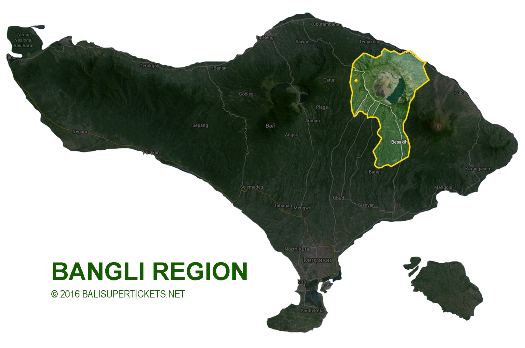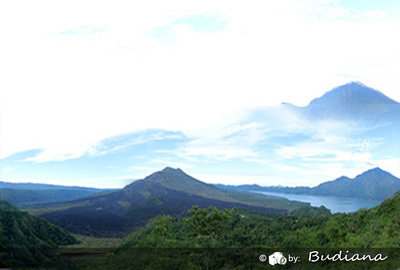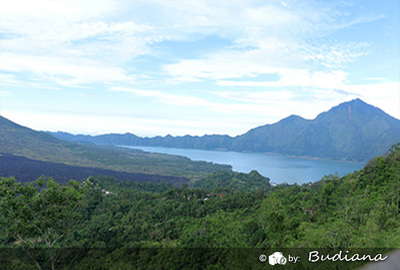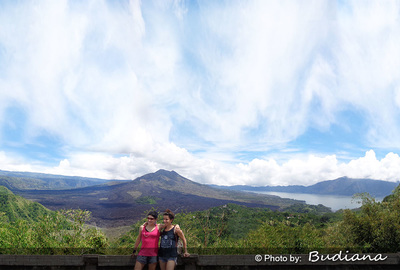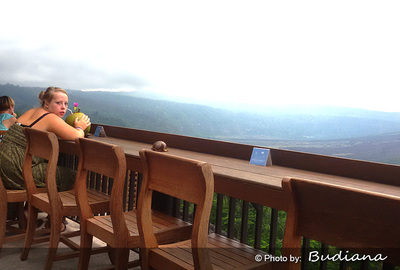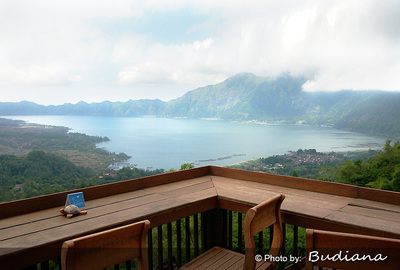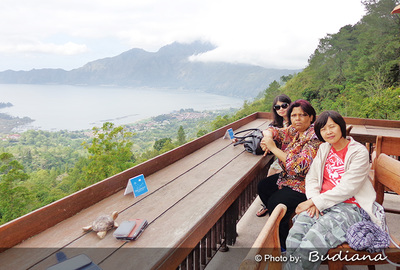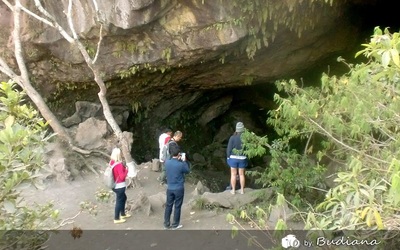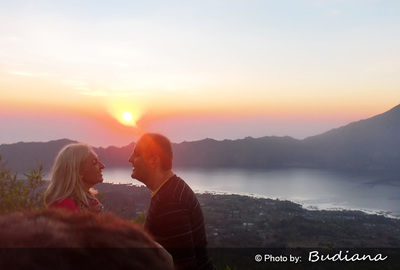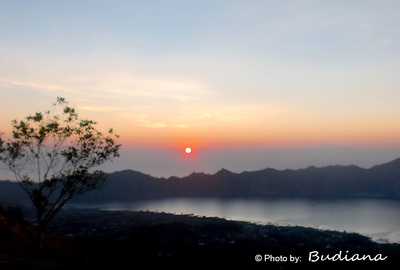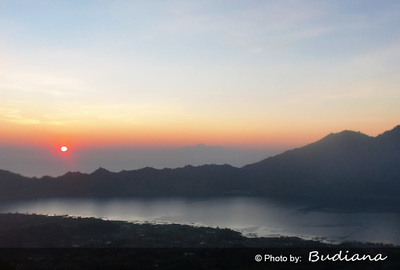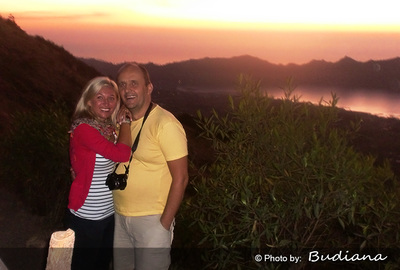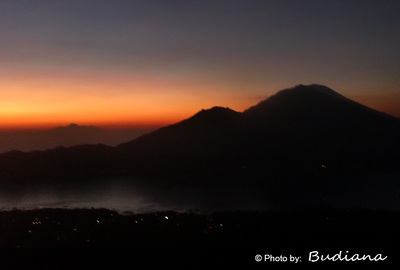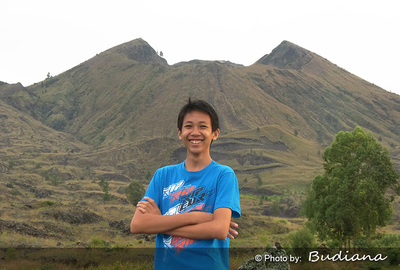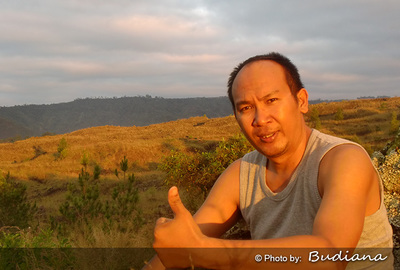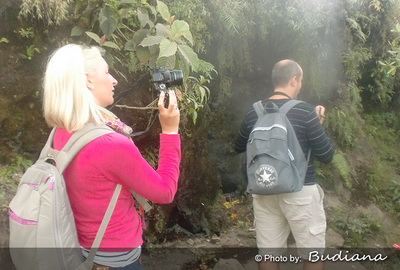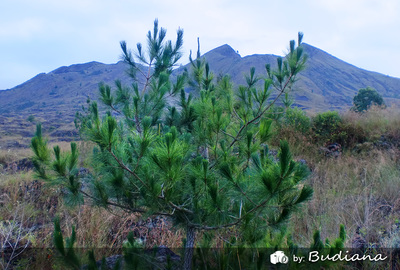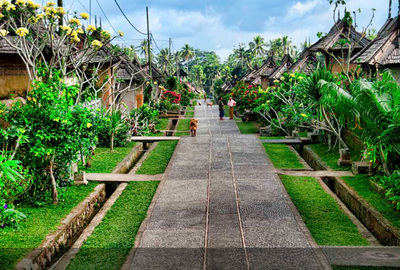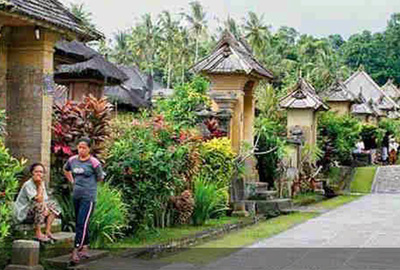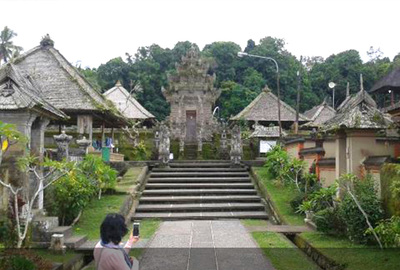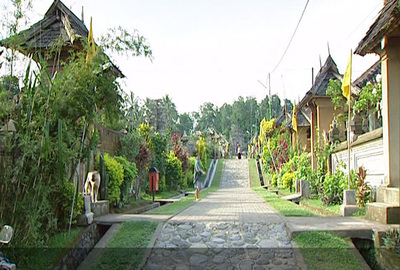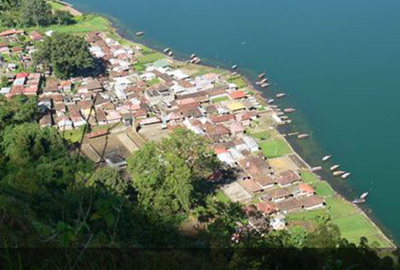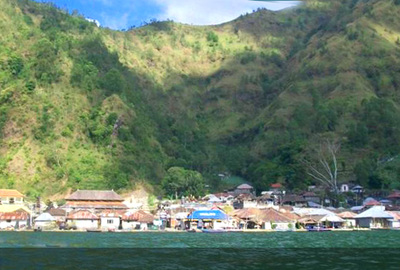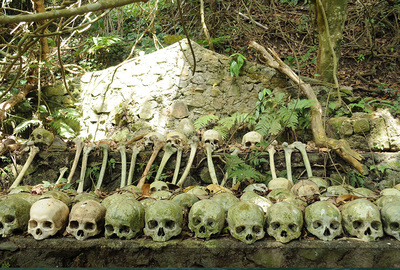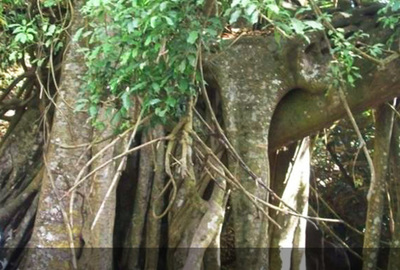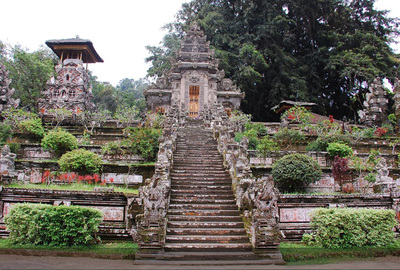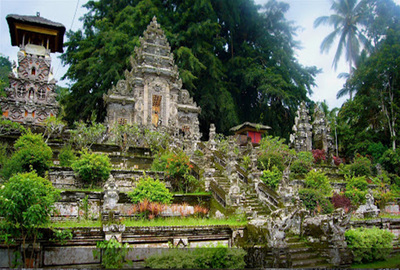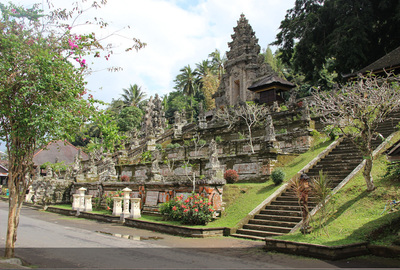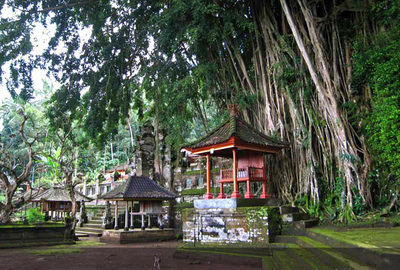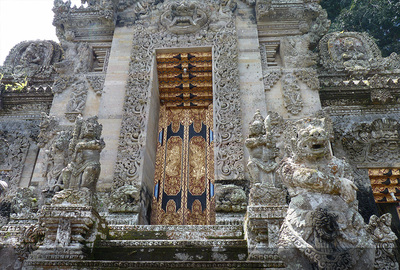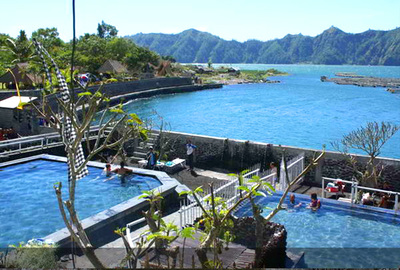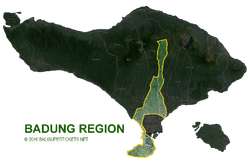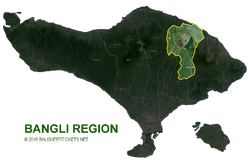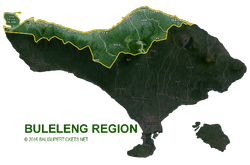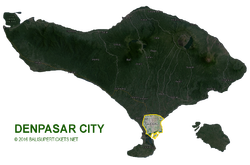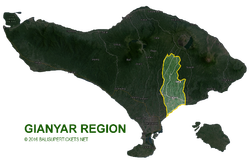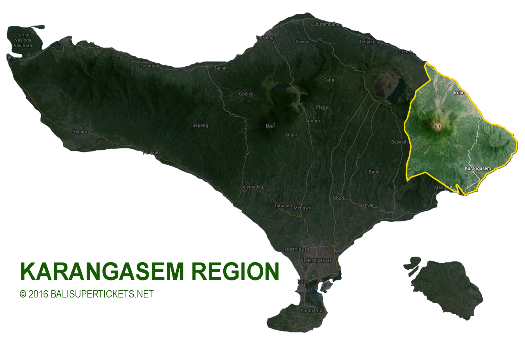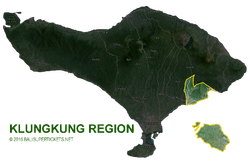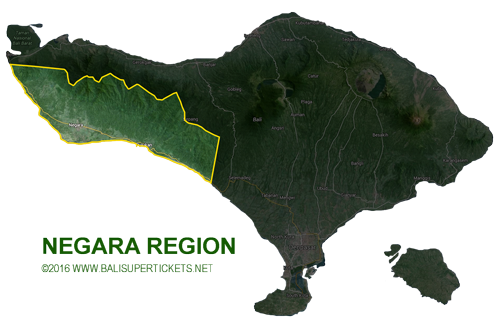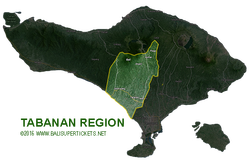Abang, Mount: Lies on the eastern side of the crater southeast of Kintamani, is the highest point on Batur's outer crater with elevation of 2,152 meters. Climbing it is easier than climbing Gunung Batur but still demanding to get different panoramic view of the old Batur volcano. Some trails also lead to Truyan Village in the northern side of the mount slope.
Bangli Town: This clean and well-maintain small town has won several yearly provincial town competition. Perhaps, because of its cool temperature, the Bali's largest mental hospital is built within this up land town.
Batur: Batur is the name for the lake, mount, temple and village in Kintamani district. Batur lake elevated 1,031 meters above sea level with 1.5 km long time 2.5 km width and up to 70 meters deep. The waters of the lake feed underground rivers. The present Mount Batur, with elevation of 1717 meters, is in fact the younger and smaller then the former mount, with elevation over 3500 meters, that was erupted thousand years ago. The present mount Batur has also erupted in 1917 that took the lives of 1,000 people, destroying 65,000 homes and 2,500 temples. Batur mountain is the most frequent climbed mountain by tourist. The Batur temple is constructed by black frozen lava stone and consider as the second important temple of Bali after Besakih temple. Do you want to getGreat Tour Deals to see the sunrise from the top of this active volcano? Related tour program for Batur Click here
Kedisan: A farming and fishing village with a mild and enjoyable weather, the village located on the western shore of the lake Batur, directly beneath of Penelokan. It has market area, extensive gardens of oranges, corn, and peanuts, souvenir shops, bemo terminal, a big parking lot, ticket office, and boat landing from or to Trunyan ot Toyabungkah. The existence of several clean and low budget accommodation around the village make it a good base to climb mount Batur, Abang, going to Trunyan.
Kintamani: It is the name of the sub-district area as well as the name of the village lies the western outer rim of the old Batur caldera. With evevation of 1,500 above the sea level the area is cool and fresh retreat. The sub-district town and the village ceter is noted by big traditional market, and police station located north of Batur temple. Do you want to get Great Tour Deals to see the magnificent view of Kintamani? Related tour program for Kintamani Click here
Penelokan: The best view is from Penelokan, a little to the west around the crater from Kintamani, and from where one can see the cone of Mount Batur smoldering away and the black traces of its explosion on the landsjdlisibluee of the crater.A rather treacherous road leads from Penelokan down the crater to Toyah Bungkah, where soothing hot springs on the edge of the crater lake have recently been tapped off to create a magnificent spa complex. Do you want to get Great Tour Dealsto see the magnificent view of Kintamani? Related tour program for Penelokan Click here
Penglipuran Village: Located northwest of Bangli town, Panglipuran Village that lies 700 meters above the sea level has a unique village layout, architecture and tradition. The village main temple built at a higher land north of the village than villager's houses descended until the end of the village. The uniformity of house compound layout, building shape, and the material made for building's wall and gates, all made of mud of clay, as well as the sliced bamboo roof made unique amongst other village in Bali. There is a sacred bamboo forest with about 15 kinds of bamboo located north of the village.
Penulisan: Based on the typical old stone statues consisting the courtyard of the temple is considered as the mountain sanctuary of the kings of the Pejeng dynasty. It elevated 1,745 meters on the northwest of outer edge of Batur crater. This remote temple is worth to visit on the way from south to north Bali by passing Kintamani.
Pura Kehen: This state temple belong to Bangli region is located 1.5 km northeast of Bangli town. Pura Kehen is built on terraces on the southern slope of the hill under a big old banyan tree. Each of the three main terraces is connected to the one above by a flight of stairs.
Toya Bungkah: Lying on the northwest shore of Lake Batur, the climbing based village of Toya Bungkah features an invigorating hot springs, massive cinemascopic views, a small black-sand beach, and several comfortable cheap and moderate accomodation.A private establishment has setup a big cool water fed swimming pool and several hot water plunge pools for climbers refreshment. Sutan Takdir Alisjahbana, a North Sumatran novelist, philosopher, and painter resided here once and established an Toya Bungkah art center in 1971.
Trunyan: One of Bali Age (indigenous Balinese) village, it can easily be reach by both from Toya Bungkah and commonly from Kedisan Village. Unlike other Balinese, Trunyan people prefer exposing their dead in the open air rather than cremating them. Began by religious rites, the naked dead body is first wrapped in white cloth, then placed in a shallow pit, protected from scavengers by a triangular bamboo fence and roof. This gravesite is the most interesting part of the village beside Trunyan's rarely held festivals featuring wooden ferris wheels and masked dancers who whip bystanders.
Bangli Town: This clean and well-maintain small town has won several yearly provincial town competition. Perhaps, because of its cool temperature, the Bali's largest mental hospital is built within this up land town.
Batur: Batur is the name for the lake, mount, temple and village in Kintamani district. Batur lake elevated 1,031 meters above sea level with 1.5 km long time 2.5 km width and up to 70 meters deep. The waters of the lake feed underground rivers. The present Mount Batur, with elevation of 1717 meters, is in fact the younger and smaller then the former mount, with elevation over 3500 meters, that was erupted thousand years ago. The present mount Batur has also erupted in 1917 that took the lives of 1,000 people, destroying 65,000 homes and 2,500 temples. Batur mountain is the most frequent climbed mountain by tourist. The Batur temple is constructed by black frozen lava stone and consider as the second important temple of Bali after Besakih temple. Do you want to getGreat Tour Deals to see the sunrise from the top of this active volcano? Related tour program for Batur Click here
Kedisan: A farming and fishing village with a mild and enjoyable weather, the village located on the western shore of the lake Batur, directly beneath of Penelokan. It has market area, extensive gardens of oranges, corn, and peanuts, souvenir shops, bemo terminal, a big parking lot, ticket office, and boat landing from or to Trunyan ot Toyabungkah. The existence of several clean and low budget accommodation around the village make it a good base to climb mount Batur, Abang, going to Trunyan.
Kintamani: It is the name of the sub-district area as well as the name of the village lies the western outer rim of the old Batur caldera. With evevation of 1,500 above the sea level the area is cool and fresh retreat. The sub-district town and the village ceter is noted by big traditional market, and police station located north of Batur temple. Do you want to get Great Tour Deals to see the magnificent view of Kintamani? Related tour program for Kintamani Click here
Penelokan: The best view is from Penelokan, a little to the west around the crater from Kintamani, and from where one can see the cone of Mount Batur smoldering away and the black traces of its explosion on the landsjdlisibluee of the crater.A rather treacherous road leads from Penelokan down the crater to Toyah Bungkah, where soothing hot springs on the edge of the crater lake have recently been tapped off to create a magnificent spa complex. Do you want to get Great Tour Dealsto see the magnificent view of Kintamani? Related tour program for Penelokan Click here
Penglipuran Village: Located northwest of Bangli town, Panglipuran Village that lies 700 meters above the sea level has a unique village layout, architecture and tradition. The village main temple built at a higher land north of the village than villager's houses descended until the end of the village. The uniformity of house compound layout, building shape, and the material made for building's wall and gates, all made of mud of clay, as well as the sliced bamboo roof made unique amongst other village in Bali. There is a sacred bamboo forest with about 15 kinds of bamboo located north of the village.
Penulisan: Based on the typical old stone statues consisting the courtyard of the temple is considered as the mountain sanctuary of the kings of the Pejeng dynasty. It elevated 1,745 meters on the northwest of outer edge of Batur crater. This remote temple is worth to visit on the way from south to north Bali by passing Kintamani.
Pura Kehen: This state temple belong to Bangli region is located 1.5 km northeast of Bangli town. Pura Kehen is built on terraces on the southern slope of the hill under a big old banyan tree. Each of the three main terraces is connected to the one above by a flight of stairs.
Toya Bungkah: Lying on the northwest shore of Lake Batur, the climbing based village of Toya Bungkah features an invigorating hot springs, massive cinemascopic views, a small black-sand beach, and several comfortable cheap and moderate accomodation.A private establishment has setup a big cool water fed swimming pool and several hot water plunge pools for climbers refreshment. Sutan Takdir Alisjahbana, a North Sumatran novelist, philosopher, and painter resided here once and established an Toya Bungkah art center in 1971.
Trunyan: One of Bali Age (indigenous Balinese) village, it can easily be reach by both from Toya Bungkah and commonly from Kedisan Village. Unlike other Balinese, Trunyan people prefer exposing their dead in the open air rather than cremating them. Began by religious rites, the naked dead body is first wrapped in white cloth, then placed in a shallow pit, protected from scavengers by a triangular bamboo fence and roof. This gravesite is the most interesting part of the village beside Trunyan's rarely held festivals featuring wooden ferris wheels and masked dancers who whip bystanders.

